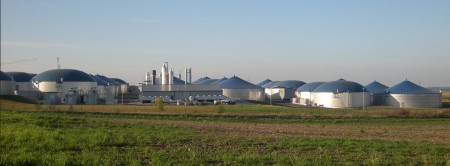Sep
16
Getting Ready to Add Biomethane to Natural Gas
September 16, 2014 | Leave a Comment
Adding Biomethane (methane from biomass) to the natural gas supply is held up by lack of standardized and international content conditions. An effort to generate further growth has come from the Helmholtz Center for Environmental Research (UFZ), the German Biomass Research Center (DBFZ), other Members of the IEA Task 37 (Energy from Biogas) and the Task 40 (Sustainable Bioenergy Trade).
Biomethane would work as a substitute for the fossil derived natural gas offering a variety of options and applications for a sustainable energy supply. While the general abundance of natural gas in the U.S. keeps North America freed from worry, the situation in Europe and much of Asia is fraught with risk as “Putinism” rises from the old Soviet Union. The situation across Western Europe and some former soviet states is quite serious.

Biomethane Production Plant. According to the report some 277 biogas upgrading plants in different countries with a production capacity of around 100,000 Nm³/h of biomethane are already in operation. Image Credit: DBFZ Click image for the largest view.
Nevertheless, in most of the IEA member states natural gas still plays an important and increasing role in the national energy supply. This is because of a well-developed infrastructure of gas networks, natural gas fueling stations, and various modes of portable transportation. Due to the significantly lower greenhouse gas emissions, the protection of finite resources, and especially now energy security several countries initiated support programs for biomethane (methane from biomass). Now several countries have initiated the gradual transition from fossil natural gas resource on to renewable energy sources of biomethane.
The researchers noted above have published their study “Biomethane – Status and Factors Affecting Market Development and Trade,” giving an up-to-date and comprehensive overview of the production technologies of biomethane (upgrading of biogas and Bio-SNG), the grid injection and the use in various IEA member states.
Te report is a quite well written and organized piece available in a downloadable pdf file. For those in the biomethane, natural gas industry, or an interested investor or customer it is a highly enlightening work.
In addition to the description of the framework, the options and needs for the development of larger biomethane supply strategies are also illustrated. The authors finalize the study with concrete recommendations how the remaining barriers can be removed and the market development can be promoted step by step.
Biomethane offers considerable benefits including independence from natural gas imports, the strengthening of farm and forestry economies and its promising application areas as a motor fuel, used for cogeneration, and home and industrial heating.
For the final composition of biomethane it must be consistent with the various natural gas quality levels in the market before it can serve as a substitute for natural gas. Preprocessing is somewhat different, the contaminants include different mixes of CO2, nitrogen, sulfur, and water vapor.
The market is pretty well advanced. Some 277 pilot sized plants are already in operation in primarily in Europe and in North America. So far though, even the international natural gas market is mostly regional, putting biomethane at something of a disadvantage.
An international biomethane market is, according to the study, still in its infancy. However, various strategies, investment programs, funding and utilization concepts have been adopted in the investigated countries. Because of the complex supply chain there are various ecological, economic, administrative and political barriers for a market implementation of biomethane.
For a sustainable and international implementation appropriate technical standards, sustainability requirements and political as well as financial support (compensation / promotion / preference), in order to significantly advance the development of an international biomethane trade, are necessary.
The study will provide interested persons a useful tool to assist others in understanding what is needed to firm up, for the immediate future, the European gas market. This study as well as the very recent announcement of a Liquid Natural Gas Market opening should light quite a fire of effort to add to Eurasian supplies. It may not be in time to save the Ukrainians from Putinism and its ravages, but it looks to ravage the Putinism command economy in the coming years as gas supplies for Europe increase and diversify.

